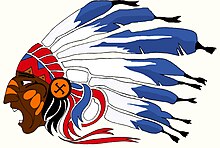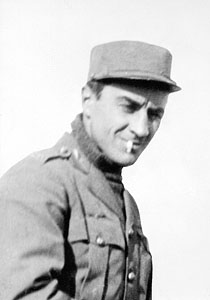Lafayette Escadrille: Difference between revisions
Reedmalloy (talk | contribs) No edit summary |
|||
| Line 26: | Line 26: | ||
*[[Hobey Baker]] |
*[[Hobey Baker]] |
||
*[[Clyde Balsley]] |
*[[Clyde Balsley]] |
||
*[[Eugene Bullard]] |
|||
*[[A. Courtney Campbell]] |
*[[A. Courtney Campbell]] |
||
*[[Victor Chapman]] (1890-1916) The first American aviator to be killed in World War I |
*[[Victor Chapman]] (1890-1916) The first American aviator to be killed in World War I |
||
Revision as of 21:15, 22 August 2008

The Lafayette Escadrille (from the French Escadrille de Lafayette), also known as the Lafayette Flying Corps, was a squadron of the French Air Service, the Aéronautique militaire, during World War I composed largely of American volunteer pilots flying fighters.
The squadron was formed in April 1916 as the Escadrille américaine (number 124) in Luxeuil prior to U.S. entry into the war. Dr. Edmund L. Gros, director of the American Ambulance Service, and Norman Prince, an American expatriate already flying for France, led the efforts to persuade the French government of the value of a volunteer American air unit fighting for France. The aim was to have their efforts recognized by the American public and thus, it was hoped, the resulting publicity would rouse interest in abandoning neutrality and joining the fight.
(In fact higher numbers of American volunteers served with the Royal Flying Corps, Royal Naval Air Service and Royal Air Force during the conflict.)
The squadron was quickly moved to Bar-le-Duc, closer to the front. A German objection filed with the U.S. government led to the name change in December over the actions of a supposed neutral nation. The original name implied that the U.S. was allied to France when it was in fact neutral like Sweden.
The planes, their mechanics, and the uniforms were French, as was the commander, Captain Georges Thenault. Five French pilots were also on the roster, serving at various times. Raoul Lufbery, a French-born American citizen, became the squadron's first, and ultimately their highest claiming, flying ace with 16 confirmed victories before his squadron was transferred to the US Air Services.
Combat
The first major action seen by the squadron was at the Battle of Verdun, being posted to the front in May 1916 until September 1916, when the unit moved to 7 Army area at Luxeuil. The squadron, flying the Nieuport scout, suffered heavy losses, but its core group of 38 was rapidly replenished by other Americans arriving from overseas. So many volunteered that a "Lafayette Flying Corps" was formed in part to take the overflow, many Americans thereafter serving with other French air units. Altogether, 265 American volunteers served in the Corps. Although not formally part of the Lafayette Escadrille, other Americans such as Michigan's Fred Zinn, who was a pioneer of aerial photography, fought as part of the French Foreign Legion and later the French Aéronautique militaire.
Sixty-three Corps members died during the war, 51 of them in action against the enemy. The Corps is credited with 159 enemy kills. It amassed 31 Croix de guerre, and its pilots were awarded seven Médailles militaires and four Légions d'honneur. Eleven of its members were deemed flying aces, claiming 5 air kills or more. The core squadron suffered 9 losses and was credited with 41 victories.[1]
The Escadrille had a reputation for daring, recklessness, and a party atmosphere.[citation needed] Two lion cubs, named "Whiskey" and "Soda", were made squadron mascots.
Lufbery got into trouble for hitting an officer who was unwise enough to lay hands on him during an argument. He was rescued from jail by his squadron mates. He was a man after the heart of French ace Charles Nungesser who came calling on the escadrille during one of his convalescences. He borrowed a Spad and shot down another German plane even though he was officially grounded.
On 8 February 1918, the squadron was transferred to the United States Army Air Service as the 103rd Pursuit Squadron. For a brief period it retained its French planes and mechanics. Most of its veteran members were set to work training newly-arrived American pilots. The 103rd PS claimed a further 49 kills up until November 1918.
Members

- Hobey Baker
- Clyde Balsley
- A. Courtney Campbell
- Victor Chapman (1890-1916) The first American aviator to be killed in World War I
- Elliot C. Cowdin
- Marsh Corbitt (1890-1988) Ace
- Edmond Genet The first American flier to die after the United States declared war against Germany
- Bert Hall (1885-1948) Film Director, Actor, Writer & Lieutenant. Wrote two books about being a "Flyboy" in the Lafayette Escadrille.
- James Norman Hall (1887-1951), co-author of Mutiny on the Bounty and Falcons of France about the Lafayette Escadrille
- Willis Haviland
- Tommy Hitchcock, Jr. (1900-1944), star professional polo player, later assistant air attache to the US Embassy in Great Britain during World War II
- Walter Lovell
- Raoul Lufbery (1885-1918), an ace who died in combat after jumping from the tail of his burning fighter plane.
- Didier Masson (1886-1950)
- James R. McConnell
- Charles Nungesser (1892-1927)
- Edwin C. "Ted" Parsons
- Frederick H. Prince, Jr. (1885-1963)
- Norman Prince (1887-1916), Founder and ace
- Kiffin Rockwell
- William Thaw
- Gill Robb Wilson
Tributes
- A statue by the sculptor Gutzon Borglum titled The Aviator (1919) was erected on the grounds of the University of Virginia in Charlottesville, Virginia United States in the memory of James R. McConnell, a member of the squadron who was killed during the War. McConnell wrote a first-hand account of the war, Flying in France,[1] that gives the reader invaluable insight into the war in France from 1915 until his death in 1917. Letters added to the end of the book include an account of McConnell's demise.
- Lafayette Escadrille Memorial, Villeneuve-l'Étang Imperial Estate, in Marnes-la-Coquette, Hauts-de-Seine, outside of Paris, France, 1928
- Norman Prince tomb, Washington National Cathedral,United States.
- James R. McConnell. Two memorials are located in Carthage, North Carolina, United States. The first is a granite column flanked by two cannon, the other is a granite stone inscribed in the French language at the community house.
Popular culture
The story of the Lafayette Escadrille has been adapted into two films: Lafayette Escadrille (1958), a William A. Wellman movie starring Tab Hunter, and Flyboys (2006), directed by Tony Bill and starring James Franco. The Lafayette Escadrille also appears in "Attack of the Hawkmen," an episode of The Young Indiana Jones Chronicles in which Indy is temporarily assigned to the group as an aerial reconnaissance photographer.
The exploits of the Lafayette Escadrille are also captured in several works of historical fiction including: Falcons of France by Charles Nordhoff and James Norman Hall (1929), To the Last Man by Jeffrey Shaara, Valiant Volunteers by Terry L. Johnson (2005), and An Ace Minus One by Timothy Morrisroe (2006).
See also
- Eagle Squadron—American volunteers in the RAF during World War II
- Flying Tigers—American volunteers who fought for the ROC in the Sino-Japanese War
- Kościuszko Squadron—American volunteers fighting for Poland in the Polish-Soviet War (1919-1921)
References
Notes
- ^ Bailey, Frank and Franks, Norm. A Complete Record of the Fighter Aces and Units of the United States and French Air Services. London: Grub street, 1992. ISBN 0-94881-754-2.
Bibliography
- Bowen, Ezra. Knights of the Air. New York: Time Life Books Aviation Series, 1980. ISBN 0-80943-252-8.
- Brown, Walt, Jr. An American for Lafayette: The Diaries of E.C.C. Genet, Lafayette Escadrille. Charlottesville Virginia: University Press of Virginia, 1981. ISBN 0-81390-893-0.
- Morse, Edwin W. America in the War: The Vanguard of American Volunteers in the Fighting Lines and in Humanitarian Service, August, 1914–April, 1917. New York: Charles Scribner's Sons, 1919.
- Nordhoff, Charles and Hall, James Norman. The Lafayette Flying Corps. Boston and New York: Houghton Mifflin Company, 1920.
- Parsons, Edwin C. I flew wth the Lafayette Escadrille. Indianapolis. E. C. Seale and Company, Inc., 1930 first edition, reprint 1953.
- Shaara, Jeff. To the Last Man: A Novel of the First World War. New York: The Random House Publishing Group, 2004. ISBN 0-345-46134-7.
External links
- Lafayette Pilots' Memorial
- James McConnell's book, Flying in France
- History of the Escadrille
- New England Air Museum's Lafayette Escadrille Online Exhibit
- Query regarding Lafayette Escadrille & Lafayette Flying Corps
- Motivations of the Lafayette Escadrille Pilots by Guy Nasuti
- Valiant Volunteers by Terry Johnson
- Philippe D. Rogers, L'escadrille Lafayette : unité de combat volontaire oubliée de l'Amérique English version
- Philippe D. Rogers, L'escadrille Lafayette : unité de combat volontaire oubliée de l'Amérique Version française
